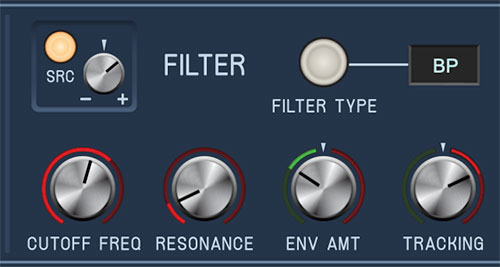
Sines features a resonant multimode filter, including four lowpass modes, highpass, bandpass, and notch modes for all manner of sound sculpting.
Controls
Cutoff Frequency and modulation- Sets the frequency where frequency attenuation begins, i.e. which frequencies are allowed to pass, dependent on the current Filter Modes setting. The modulation controls above include a mod source button (Src) that allows selection of a mod source, plus an attenuverter to set the amount of positive or negative modulation.
Filter Type- These select the overall filter curves. The popup menu can be opened by clicking on the button or display window:
LP4 (Lowpass)- Allows frequencies below the cutoff frequency to pass, but blocks frequencies above the cutoff frequency with a 24 dB/oct slope. The "4" refers to the number of filter poles and because of its steep cutoff, this the "darkest" of the filters. It also has the most pronounced resonance effect.
LP3 (Lowpass)- Allows frequencies below the cutoff frequency to pass, but blocks frequencies above the cutoff frequency with an 18 dB/oct slope. The "3" refers to the number of filter poles
LP2 (Lowpass)- Allows frequencies below the cutoff frequency to pass, but blocks frequencies above the cutoff frequency with a 12 dB/oct slope. The "2" refers to the number of filter poles
LP1 (Lowpass)- Allows frequencies below the cutoff frequency to pass, but blocks frequencies above the cutoff frequency with a 6 dB/oct slope. The "1" refers to the number of filter poles and because of its shallow cutoff, this the brightestof the filters with the least pronounced resonance effect.
HP (Highpass)- Allows frequencies above the cutoff frequency to pass, but blocks frequencies below the cutoff frequency with a 12 dB/oct slope. Because they dramatically remove low frequencies, the highpass setting is useful for nasally tones with exaggerated high frequencies.
BP (Bandpass)- Allows a band of frequencies in the vicinity of the cutoff frequency to pass, with a 12 dB/oct slope.
Notch- Removes a band of frequencies close to the cutoff frequency and allows all other frequencies to pass. Notch filters are useful for pseudo-phaser effects when their cutoff frequency is swept, but that's notch-yer-problem. (See what we did there? Come for the synths, stay for the dad jokes...)
Resonance- Resonance emphasizes sound energy at and around the current cutoff frequency by adding feedback from the filter's output back to its input. At lower settings, this can be used to create mild resonances such as those heard in acoustic instruments. At extreme settings, it can be used as a sine wave generator, but be careful as high resonance settings can result in loud, screamy, dog-spooking (and speaker blowing) occurrences.
Envelope Amount- The Env Amt control applies modulation from the Filter Envelope to the cutoff frequency. This allows familiar auto filter sweeps. When raising the Envelope control, you'll generally want to lower the Cutoff control, as these controls sum. Please see the Envelope Generators section for more info about the Filter Envelope.
Tracking- This causes the cutoff frequency to increase as ascending notes are played on a keyboard. The idea behind this is that when set to positive values, the Tracking control applies a rising CV to the cutoff frequency in order to maintain the brightness of notes as higher pitches are played (because actual note frequencies rise as higher pitches are played). When turned counterclockwise from center, the Tracking control causes the cutoff frequency to get lower as higher keys are played.